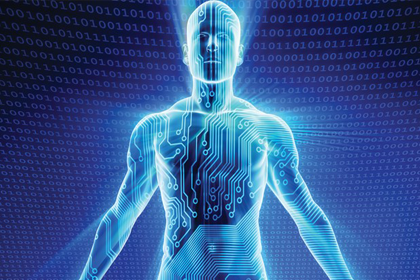Today, in the era of AI, medical digital twins hold great promise for helping diagnose and treat the population in the future. UVM Professor Gary An, M.D., a surgeon and computational biology and mathematical modeling expert, has been working on developing and researching computational models for such diseases as sepsis and COVID-19 for over 20 years. His recent research has centered on developing digital twins of the human immune system.

(Stock image depicts a digital version of a human)
Remember the Human Genome Project? Biomedical scientists and physicians thought mapping our genome would help solve all our medical questions and dilemmas. That 13-year-long project was completed 20 years ago, and we still haven’t cured cancer or the common cold, among a host of other medical challenges.
Today, in the era of AI, medical digital twins hold even greater promise for helping diagnose and treat the population in the future.
Pioneered by industry in the early 2000s, digital twins provide a virtual replica of a system or physical object and have been critical to the success of assembly lines worldwide. The technology relies on data links between the digital and physical entities to ensure accurate representation. These customized models can then be used in simulations to help diagnose and maintain the physical object.
In healthcare’s quest for precision medicine, the creation of medical digital twins that can mimic physical situations have become an increasingly popular goal, but realizing it is challenging. A principal challenge, according to Gary An, M.D., newly-appointed Green and Gold Professor of Trauma and Critical Care and vice chair of research in the University of Vermont’s Department of Surgery, is the development of sensors and devices to capture data necessary to personalize a digital twin.
“Since the thing that distinguishes a digital twin from a simulation model is the ongoing back and forth of data between the real and virtual world, a primary goal in the development of digital twins is identifying the key types of data that can allow the digital twin to best serve its intended purpose, be it forecasting behavior or identifying means of effectively controlling the real-world object,” An explains. “Sometimes the ability to acquire that data doesn’t currently exist, but the insights derived from medical digital twins will spur the development of such new technologies,” he adds.
A surgeon as well as a computational biology and mathematical modeling expert, An has been working on developing and researching computational models for such diseases as sepsis and COVID-19 for over 20 years. In a nutshell, he uses such tools as modeling methodology, machine learning/artificial intelligence, and high-performance computing to help “develop therapies for the injured and critically ill,” he says. An currently serves on the National Institutes of Health’s Multiscale Modeling Consortium Working Group on Digital Twins.
"Digital twins have the potential to revolutionize biomedical research, from personalized medicine to pharmaceutical development," says An, who presented on the use of digital twins for biomedical research during a panel titled "Connecting Across Scales" for a National Academies virtual workshop held on January 30, 2023. He also presented on developing immune digital twins at the University of Paris-Saclay Pascal Institute’s workshop in May 2023.
An’s recent research has centered on developing digital twins of the human immune system. He is a coauthor on a May 2022 article in npj Digital Medicine titled “Building digital twins of the human immune system: toward a roadmap.” The outline for a roadmap to creating an immune digital twin involves taking multi-scale biological data – at the body, organ, tissue, cellular, and molecular levels – and feeding that information into a digital model that conducts data integration, analysis, and modeling, and performs computer-based simulations which can then provide personalized diagnoses, prognoses, and optimal therapies.
“Because the immune system plays an important role in such a wide range of diseases and health conditions, from fighting pathogens to autoimmune disorders, digital twins of the immune system will have an especially high impact,” write An and his coauthors.
An specializes in the development of high-resolution, mechanistic simulation models of cellular behavior for digital patient groups that can be used in drug discovery and computer-based clinical trials.
“This work involves the conversion of the knowledge generated by experimental cellular and molecular biology into computer models (agent-based models) that integrate all that disparate knowledge into an entire simulated patient,” says An, who published a paper in Frontiers in Systems Biology in June 2022 with his colleague and research collaborator R. Chase Cockrell, Ph.D., assistant professor of surgery and theoretical physicist.
He and his colleagues utilize the same machine learning and AI tools that were used to train AIs to beat human masters of chess and other games. The goal of this research, says An, is to enhance the efficiency of drug development and testing, and provide a way to personalize treatment for all potential patients.
The methods that An and Cockrell have developed for sepsis provide an innovative way to generate simulated patients and use AI to develop potential personalized treatment strategies. Currently, notes An, there are no approved/effective drugs that address the underlying biology of sepsis. Their methods “are also applicable to wound care, and our group is currently funded by the Defense Advanced Projects Agency (DARPA) as part of a collaboration to develop a ‘smart bandage’ that can regrow muscle in the types of wounds that might arise for blast injuries,” says An. He and his colleagues developed the AI “brain” that will control the bandage.
“The ultimate goal of medicine is to provide the right treatment for the right patient at the right time and be able to have a treatment for every patient,” says An, adding, “The development of medical digital twins that integrate the exploratory power of knowledge-based mechanistic simulation with the analytical capabilities of advanced AI will go a long way towards meeting that aspirational goal.”